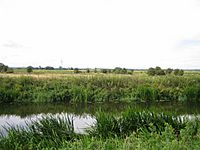Wet Moor facts for kids
| Site of Special Scientific Interest | |
 |
|
| Area of Search | Somerset |
|---|---|
| Coordinates | 51°00′59″N 2°47′18″W / 51.01631°N 2.78830°W |
| Interest | Biological |
| Area | 491 hectares (4.91 km2; 1.90 sq mi) |
| Notification | 1985 |
Wet Moor is a special natural area in Somerset, England. It covers about 491 hectares, which is like 1,214 football fields! This area is officially known as a Site of Special Scientific Interest (SSSI). It was given this important title in 1985 because of its amazing wildlife and unique natural features.
Wet Moor is part of the larger Somerset Levels and Moors. These areas are famous for their wide-open grasslands and many ditches. These ditches help manage the water across the land.
Contents
What Makes Wet Moor Special?
Wet Moor is a very flat, low-lying area. This kind of land is common in the Somerset Moors and Levels. It's a bit like a giant, flat basin.
Rivers and Waterways
Two big rivers flow through Wet Moor: the River Parrett and the River Yeo. These rivers are like the main highways for water in the area. They have high banks, almost like walls, to keep the water flowing. This helps carry water from higher lands down to the sea.
How Water Shapes the Land
Sometimes, when there's a lot of rain, the rivers can get very full. If the water gets too high, it can spill over the banks and spread across the low-lying moorland. This might sound like a flood, but it's a natural part of Wet Moor's environment. The water stays on the moor until the river levels go down again. This natural flooding helps keep the land wet, which is perfect for certain plants and animals.
Wildlife at Wet Moor
The rivers and wet lands of Wet Moor are home to many different kinds of wildlife. It's a great place for birds, especially in winter.
Whooper Swans
One of the most exciting visitors to Wet Moor in winter is the whooper swan. These large, beautiful white birds travel long distances to spend the colder months here. They love the wet grasslands and calm waters that Wet Moor provides.

